Original and unusual names for parrots

When we have a pet, we strive to learn as much as possible about it in order to create the most comfortable living conditions for it. In this article we will talk about choosing a name for a parrot, the history of their interaction with people.
Parrots live in all parts of the world, except for Europe, Siberia and the northern part of Asia, and of Antarctica, of course. They are very unpretentious, do not take up much space, and do not make it difficult to care for them. Apart from that, parrots are very friendly, well tamed and have an amazing ability to mimic human speech. All this provided them with popularity since ancient times. They were the first to be tamed in India, where they were considered sacred animals. The spread in Europe began in Greece. They were brought there by one of the generals of Alexander the Great from the Indian campaign. They quickly gained popularity in Greece, and later in the Roman Empire.
The fashion for these birds has put the entire population under threat of extinction. They were used to make stuffed animals for ladies' accessories, kept them in homes, gave them as gifts, in addition, many birds died during transportation due to improper conditions. Budgerigars, which are so popular today, appeared in Europe only in the 19th century. They immediately found universal love due to their unpretentiousness and the ease with which they mastered speech.
At the moment, societies and circles of lovers of these birds are being formed around the world, which facilitates the process of artificial breeding and selection of parrots.
Interestingly, the breeding and sale of these birds makes a significant contribution to the annual budget of the Czech Republic.
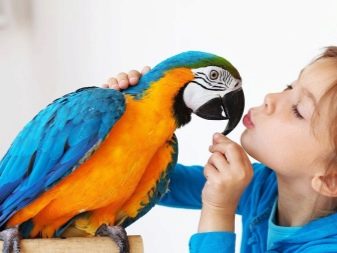
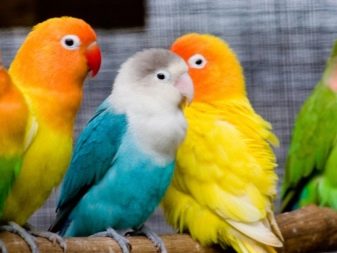
There are quite a few types suitable for home keeping.
- The famous budgies. Habitat in nature - Australia. The lifespan varies greatly: in the wild - 4–8 years, in a cage - 5–15 years. It is worth paying attention to the pedigree of the chick (some breeders may interbreed closely related individuals, which leads to hidden diseases). It is very important for little waves to be able to fly and walk - this helps them to keep themselves in good shape. It is necessary to monitor the diet of the bird: it must be balanced (if this is not done, then the bird may begin to suffer from obesity).
- Corella. It also has another name given by European naturalists - nymph. Habitat - Australia. They live there in bush and eucalyptus groves. Appeared in Europe in 1840 at an exhibition in Paris. In the 1960s, there was a ban on exporting them from their homeland, which is still in effect. This is a schooling bird with incredible endurance and love of flying. Outwardly, the Corella looks like a small pigeon of an unusual color. A distinctive feature is a crest on the head.
- Lovebirds. They got this name because of the relationship that is observed in a pair of such birds. It is believed that in the wild, the lovebird looks for a mate only once and remains faithful to her throughout her life. Habitat - about. Madagascar, Northwest and Northeast Africa. It is better to take home a lovebird raised in captivity, it is easier for the bird to adapt. The lovebird is about 14–17 cm long and weighs only 40–65 grams.
- Gray parrot... Habitat - Central Africa. Quite a large bird (40–45 cm) with a hard curved beak. Another interesting feature of the bird is its tail. It has a bright red or brown color. This bird is the best suited for interaction with humans. Jaco has a wide range of emotions, can learn up to 1,500 words, and is highly intelligent.
- Noble parrot. Has a beautiful green or red color. They are intelligent, immediate and sensual creatures, capable of strong attachment to humans. They have a fairly wide emotional range. Get along well with children. Habitat - Australia with adjacent islands and Oceania.
- Cockatoo. This species adapts well to various habitats and is found in Australia, Indonesia, New Guinea and the Philippine Islands. The bird is rather large (40–70 cm) and can weigh up to 1 kg. It has a beautiful tuft, usually of a contrasting color to the shade of the main plumage. Cockatoos are unique in handling, raising and caring for. They are very charming and intelligent birds.
- Macaw... Habitat - forests of Latin and South America, central Africa. Has a very bright color. Plumage of birds can combine several colors or be of the same color. This is a very large parrot: it can reach 100 cm, with a wingspan of 40 cm. The hyacinth macaw is the largest parrot on the planet. This bird is whimsical to care for: it needs a lot of space, you will have to carefully monitor its nutrition. In addition, macaws make harsh sounds.
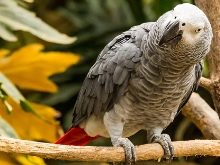

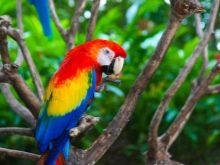
Less common pets are: a luxurious mountain parrot, monk parrots and kea.
The pet parrot, like other pets, affects the lives of the families in which they are raised. These cute funny birds quickly find contact with children, become friends with adults. They bring variety to everyday life. An interesting story happened once in the United States. The parrot helped to catch the thieves who broke into the apartment at night. They called each other by name, which the bird remembered. When the police arrived at the scene, they noticed that the bird incessantly repeats names that are not among the names of the owners.

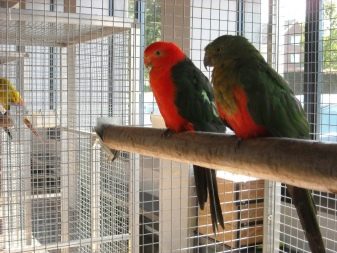
Name selection rules
In order to facilitate communication with the bird, you should choose a suitable name for it. There are a few simple rules.
- Make sure that the name you want to give the parrot is not consonant and does not repeat the names of other family members. This will make it easier for the bird to understand that it is she who is being addressed.
- Choose a nickname based on the nature and behavior of the pet.
- As a nickname, you can use the names of characters from books or cartoons.
- Choose a nickname based on the speaking ability of the bird. Each parrot species has its own set of sounds that should or should not be used.
- When choosing a name for your pet, take into account his sociability. Those who like to talk can be given rather long names, and those who are silent can be given short names.
- For budgies, choose a name with sibilant consonants and vowels "and" and "a". Birds are able to mimic the human voice, so you can choose from human names as well. It is advisable to choose short, easy-to-remember names.
- The most convenient consonants for pronunciation are "k", "p", and "p".
- It is believed that wave boys are very sociable, while girls like to be quiet.
- Cockatiels are able to reproduce even everyday noise, speak in phrases. Growling and hissing sounds are easiest for them. Their gender is rather difficult to determine, so it is better to use generic names.
- Lovebirds are often given in pairs. Inspiration can be found among famous paired names. For example, Romeo and Juliet.
- For a parrot, it is better to choose a short nickname of 2-3 syllables.
- As for the noble parrots, they are most easily given vowels and "non-stopping" consonants (such as "m", "n" or "d").
- Cockatoo are very finicky. Before giving a nickname to a bird, you need to observe its behavior and character. When giving your pet a name, watch its reaction. The bird should like her name - then she will be happy to pronounce it and respond to it.
- The "majestic" nicknames are very suitable for the posh macaw.
- For a parrot that does not show interest in human speech, it is better to choose clear and short names.

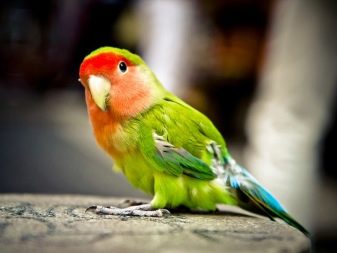
Original nicknames for the boy
- Let's start with the most common birds - budgerigars. Suitable names such as: Cheshik, Gosha, Tishik, Gavrosh, Krosh, Tishka, Richie, Kesha, Zipper, Shustrya, Hulk, Vozha, Astrik, Ara, Jarri, Baloo, Bush, Baz, Lance, Nils, Os, Sancho, Whistle, Cornflower.
- Corella can be called by such names as: Yasha, Yurash, Elvis, Era, Yarik, Tik, Shustrik, Chuck, Hipa, Epic, Luke, Kai, Gray, Brawler, Borey, Isidor, Rem, Sir, Breeze.
- Lovebirds: Nils, Robinson, Ron, Hassa, Thomas, Charles, Ottelo, Cupid, Zephyr, Pan, Jan, Draco, Keely, Vili.
- Jaco: Einstein, Philip, Forest, Elvis, Caesar, Brutus, Norman, Arabis, Thales, Xenoph, Zeno, Martin, Sigmund, Sherlock, Argus, Pegasus, Redel, Thorin.
- Noble parrot: Tima, Eric, Chad, Cheko, Citrus, Fitch, Aconite, Dickens, Ephesus, Job, Terrible, Neo, Ares, Bacchus, Cedric, Bilbo, Orion.
- Cockatoo: Charlie, Judwig, Schwartz, Chirliz, Flint, Adonis, Dartonyan, Badan, Mark, Bruno, Francis, Ostap, Hermes, Remus, Filch.
- Macaw: Theodore, Tiger, Taco, Chedar, Tsigan, Fidel, Sapphire, Ageratum, Pythagoras, Paracelsus, Immanuel, Juan, Hector, Mars, Albus.
- Cool (peculiar) nicknames for parrots: Buddha, Ichthyander, Smaug, Pechorin, Mazepa, Dobby, Sphinx, Zeus, Lucifer, Odin, Oracle, Potter, Sirius, Aragorn.
As you can see, many of the names given here were taken from myths, fairy tales, cinematography, philosophy, astronomy, history, there are also incomplete names of writers. You can look for inspiration in other areas as well.


List of names for girl parrot
- Wavy: Ket, Liz, Gaia, Kerra, Clio, Muse, Lelya, Luna, Gami.
- Lovebirds: Betty, Judy, Gerda, Hebe, Ida, Guiche, Shirley.
- Corella: Siri, Zara, Vesta, Lana, Martha, Nur, Fati, Sarah, Della, Rose.
- Jaco: Moni, Kelly, Rooney, Bloom, Rhea, Ora, Samia, Asya, Giselle, Maud, Sarla.
- Noble: Audrey, Lada, Greta, Nika, Rania, Levi, Sonya, Annette.
- Cockatoo: Aurora, Diana, Mei, Farah, Alice, Lady, Eliza, Berta, Sayuri.
- Macaw: Artemis, Daphne, Simone, Ornela, Jasmine, Verika, Amelia.
- Non-standard names: Aquamarine, Pearl, Duchess, Komako, Aslana.
- Names suitable for both boys and girls: Romi, Anouk, Yange, Kerr, Wood, Ali, Curie.
As you can see, this collection focused on film actresses, mythical characters, women scientists, cartoon characters. You can also look for inspiration in the themes of space, sea, cultures of different countries and ancient languages.
Paired names: Tristan and Isolde, Bonnie and Clyde, Sid and Nancy, Andromeda and Perseus, Gray and Assol, Orpheus and Eurydice, Fred and George, Gentleman and Lady.

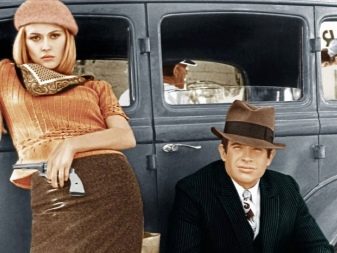
How to accustom to the name
Lack of reaction to their nickname in birds happens quite often, especially when not enough time has passed. There may be several reasons for this.
- The bird has not yet had time to get used to it.
- The name contains difficult to pronounce sounds or a combination of sounds.
- The bird doesn't like this nickname.
- The nickname is very long to remember.
- Emotional contact has not yet developed between the owner and the parrot. In this case, the bird does not react directly to humans.
- The owner addresses the bird, vaguely articulating sounds.
- Emotions of a person are aggressive in color (handling in a raised tone, with disdain or aggression).
- Perhaps the parrot is already accustomed to some other name.
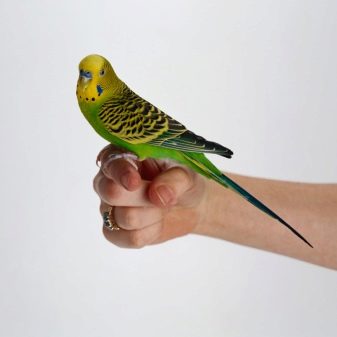

What to do in such situations?
Once a parrot gets to a new owner, it takes time to get used to the new environment. Like any animal, the parrot will observe the behavior of the new owner. In this case, the bird does not respond to the nickname, if it does not yet trust the person, does not realize that they are turning to it, the process of adaptation to new conditions is still underway. To speed up the process of establishing emotional contact, it is recommended to talk to the bird more often, pronounce its name clearly and slowly.
If the bird still does not respond to the name, then briefly postpone the process of accustoming the parrot to the name and observe its behavior. As you become more familiar with the character of your pet, you can change the original nickname to one that more closely matches the bird.
If the bird does not like its proposed nickname, then it will ruffle and tug at its feathers (parrots do this when they are under severe stress). In this case it is better not to irritate the pet and pick up a few other nicknames. There should be 3-4 of them. It is necessary to offer them to the pet one by one and see his reaction. The parrot can raise its head, move its tail, or "answer" you at the name you like.
If you notice that the pet responds to some combination of sounds, then perhaps they were present in his old name. You can offer the parrot a name containing these sounds, or wait until the bird retrains to a different combination of sounds.
Parrots, like other animals, feel very well the emotional color of words. Focusing on the emotional background of the appeal, they decide how to react. If your pet starts to get nervous in the presence of you, or he does not answer you and goes to the far corner of the cage, then you should pay attention to what emotions you experience when communicating with him. You should not shout at the bird, tell it something in a raised voice, or show disdain for it.
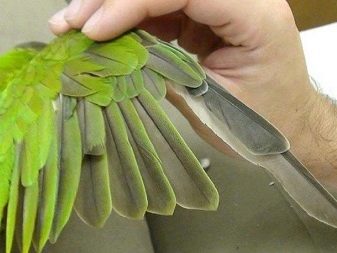
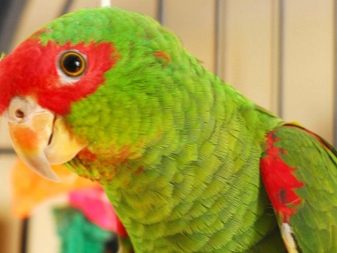
Pay attention to the bird's relationship with other pets.
In the next video, other original and unusual names for parrots are waiting for you.









I have a parrot named Zhara. It is ZHARA not ZHARA. I was looking for exotic and something of my own. My Heat likes the name. She always repeats: Heat is good, Heat is beautiful, Heat is smart. My Heat is not gray, not macaw and not wavy, this is an Australian Corella. And soon I bought a male for my Heat. I bought it when I was 11 months old. Then it turned out that I bought a female, not a male. This is how my girlfriend Zharishi appeared.I named this "male" Sherlock Holmes. Or just Sherlock. Then she renamed it to Sherla. Sherla and Zhara just became "inseparable". And now Sherla had eggs and, of course, they were empty. But I asked myself a question: why did Sherla take down the first one, although she is younger than Heat? After 3 months, I already bought real men, who were 2 years old. And I bought two so that my girls would not quarrel: "This is my boyfriend, no mine!" The first, albino, is called Ken. And the second, with the color of cockatiels, has the name Nymphs. They are slightly more aggressive towards children than girls. We had 2 cells. Each pair was placed in separate cages. Everything went very well! Eggs soon appeared. The first ones appeared at Zharishi, and after 2 days at Sherlochka, then chicks hatched. I gave them all. Here is my story about parrots.